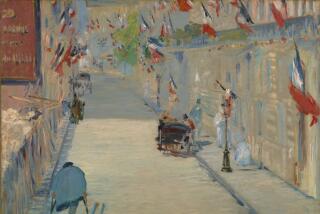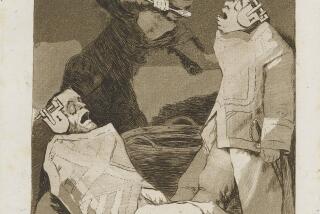‘KANDINSKY IN PARIS’: A TALE OF TWILIGHT
NEW YORK — “Kandinsky in Paris” is the final salvo in a triumvirate of Guggenheim Museum exhibitions devoted to the great modernist innovator and theoretician. The first segment surveyed 18 yeasty years in Munich, up to 1914 when he evolved the effusive non-objective abstraction which stands as his wellspring contribution to posterity.
Next came a look at his return to his native Russia, when avant-garde artists believed that the revolution was on their side. Kandinsky occupied teaching and museum posts in Moscow, but radical zeal disintegrated beneath vicious art-political infighting and mounting government rejection of modernism. When social realism became the party-line style, Kandinsky returned to Germany to teach at the legendary Bauhaus. If he was looking for a cozy pasture in which to graze in middle-age comfort, he picked the wrong puddle.
By 1934, Hitler’s hostile rhetoric and the Reichstag fire made it clear to Vassily Kandinsky and his wife, Nina, that Germany was no place for an artist linked to the Russian Revolution. They went into voluntary, if half-hearted, exile, taking an apartment in the quiet Paris suburb of Neuilly-sur-Seine. They planned to stay a year. As it turned out, the sojourn would last the rest of Kandinsky’s life.
The exhibition, on view to April 14, traces this last and rather sad chapter in the career of a great artist. He was 68, and certainly deserved a quiet place to work in the sun of honored achievement. He would not find it in Paris’ conservative Russian emigre community, which mainly scorned his sort of art. And acceptance came but slowly in Paris’ art world, a stagnating center that did not quite know who he was. It seems inconceivable to us today, but in the 1930s Kandinsky was not everywhere renowned. The textbooks that anointed him for our generation had yet to be written, the great museum collections that confirm his originality were yet unformed. And the Paris of then--like the New York of now--was inclined to feel that if it hadn’t happened there, it hadn’t quite happened.
So, once again the wanderer, Kandinsky got busy proving one more time who he was. The exhibition includes some 200 works. A brace of them are by such colleagues as Arp, Mondrian, Miro and Klee, but the bulk are Kandinsky’s own quite energetic efforts. His Paris years produced some 144 paintings and hundreds of watercolors, gouaches and drawings.
Unfortunately they are not, with significant exceptions, very good. Long gone are his days as the painter of magnificently rhetorical soulscapes full of moist, saturated colors and bold boomerang strokes. Those works seem to lead into the cosmos of consciousness, the Paris period merely natters about matters mystical.
Kandinsky took to painting crowded fields of hard-edged geometric and biomorphic shapes rendered in sweet pastels. Sometimes he composed in checkerboard grids; sometimes kidney shapes, amoeba silhouettes and fetus forms sit there amid a myriad of neat circles that look less like the old metaphysics and more like kids’ marbles.
What happened? Had the old boy just lost it, or what? And what are we the viewers supposed to do with an exhibition of major proportions that is not terrible enough to cause a nice cathartic snit or good enough to nourish aesthetic appetite?
Learn something. Read the catalogue. Try and find out how this happened.
The principal essay by Christian Derouet is redolent with facts, but its best quality is an almost novelesque ambiguity that permits the reader to piece together a picture that feels true to life. Much of it even feels familiar to our own moment.
Paris in the ‘30s comes across as vaguely stale, dominated by a conservative artistic reaction that promoted a born-again figurative artist like Andre Derain and worshiped Maurice Utrillo, Moise Kisling and the potboiler-period Maurice de Vlaminck as the patriarchs of the School of Paris. This teaches that it is possible for a great art center to be dominated for a time by third-rate talent.
Kandinsky bypassed this fashionable establishment to seek out whatever was left of the various radical turn-of-the-century movements, only to find they had largely guttered out, and their gurus were getting a bit long in the tooth too. Piet Mondrian was 62, the fiery Futurist poet Filippo Martinetti was 58 and Leger 53. The striplings of the time were Dadaist Hans Arp at 47, Miro at 41 and Alberto Giacometti a mere lad of 32, yet to see his star in its zenith.
All represented parties out of power. The names of various coalitions that they tried only attest to the entropic second-rate quality of the times. Remember such influential groups as the Circle and Square, NeoPlasticism and Concrete Art? Don’t feel badly; neither does anyone else, except specialists and scholars.
Any sensible person would ascribe much of this malaise to the spreading tide of war and the Fascist epidemic. But the artists, as if they didn’t have enough trouble, wrangled among themselves about politics both general and occupational. The Surrealists were forever drumming people out of the movement for being insufficiently Marxist. They suffered a definitive split in ranks when Stalin’s pogroms became known.
Not content to climb their high horses over global disaster, the artists went right on with pettiness-as-usual. When Mondrian visited the Kandinskys, for example, the Dutch purist turned his chair away from the park-like view from their apartment to demonstrate his scorn for the nature Kandinsky loved.
As this picture of creeping depression clarifies, it provides insight and hindsight. The insight is that the current politicization of art is still a bad idea, the hindsight is that we begin to see reasons why Kandinsky’s art looks the way it does.
He was trying to be nice.
He was trying to fit in.
Clean, hard edges doff their hat to Mondrian. Biomorphic amoeba shapes curtsy to Miro and Arp. Limp blobs acknowledge the boneless figures of Picasso’s Surrealist period. The most evidently original touch of these works is an aura of Russian peasant art that emerges from brightly patterned detail; but even that reflects a current Parisian taste for naive art. Henri Rousseau was all the rage.
None of this means that Kandinsky’s work looks sold out. It is an admirably game try at assimilation that is still clearly his own. It would be meaningful to European artists after the war, and it even effected the early abstract work of American Abstract expressionists like Adolph Gottlieb.
It was, however, inescapably art from an epoch that would likely have fizzled out even without a terrible war to hurry it along.
Kandinsky lived quietly and painted away for as long as he could. He kept in touch with the Parisian crowd and showed in small, lesser-known galleries that he regarded as serious. Group photographs of the time invariably find him standing slightly isolated, often still wearing his topcoat and appearing dignified and magisterial, like exiled royalty trying hard not to put on airs.
By 1942, conditions were so strapped that Kandinsky rarely got into the city. Art materials were in short supply, so he worked small. Paradoxically the combination of reduced scale and bleak circumstance served to galvanize the art. Wistful sweetness is replaced by expressive profundity. Skewed, meandering composition focuses into dynamic concentration. This redeeming show of strength lasted almost until the moment of his death in 1944 at age 78. The 10 years Kandinsky spent in Paris were the longest time he lived anywhere in his adult life.
More to Read
The biggest entertainment stories
Get our big stories about Hollywood, film, television, music, arts, culture and more right in your inbox as soon as they publish.
You may occasionally receive promotional content from the Los Angeles Times.










